Recent Storm Damage Posts
How To Restore Your Home After A Natural Disaster
5/1/2023 (Permalink)
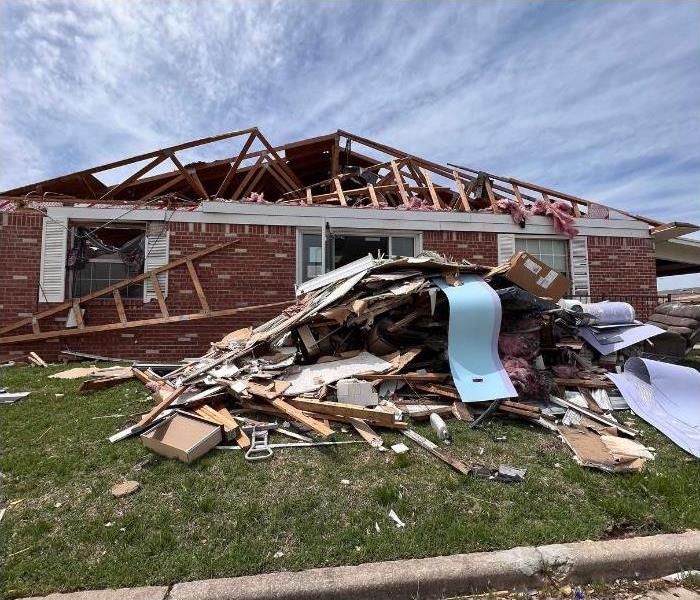 SERVPRO® of Moore is Here to Help, even on weekends. Our team of experts is on call 24/7 to respond to any emergency, no matter the size.
SERVPRO® of Moore is Here to Help, even on weekends. Our team of experts is on call 24/7 to respond to any emergency, no matter the size.
It’s been a tough year for everyone, and natural disasters have taken a toll on many homes. If your home has been affected by a severe storms, tornado, or another disaster, you may be wondering how to restore it to its former glory. Luckily, there are some SERVPRO® of Moore steps you can take to get your home back in shape. In this blog post, we’ll share some tips on how to restore your home after a natural disaster. Whether you’re dealing with water damage, wind damage, or something else, these tips will help you get your home back to normal. So if you’re ready to start the restoration process, read on!
The first step is to assess the damage. Take a look around your home and make a list of all the damaged items. Once you have a list, you can start to prioritize which repairs need to be made first. If there is structural damage, this should be your first priority. Structural damage is any damage that affects the load-bearing components of a home, such as the foundation, walls, ceilings, and/or roof. This type of damage can make a home unsafe to live in and can be very costly to repair.
In addition, if there is water damage, you will need to dry out your home and remove any mold or mildew that has formed. Water can enter your home through holes or cracks in the foundation, windows, or doors; through the roof; or from rising floodwaters. Once inside, water can damage floors, walls, furniture, and personal belongings. It can also lead to mold growth, which can pose serious health risks.
Once you have assessed the damage, it’s time to start cleaning up. First, make a plan of action. Write down what needs to be done and in what order. This will help you stay organized and avoid overlooking any important tasks. Then start with the basics. Begin by cleaning up any debris that may be inside or outside your home. This includes broken glass, downed tree limbs, etc. Finally, move on to bigger tasks next. If there is water damage, start by drying out the affected areas. Then, you can begin to repair any damage that has been done.
After you have cleaned up the debris and repaired any damage, it’s time to start thinking about prevention. Take a look at your home and identify any areas that are vulnerable to future disasters. Make sure you have strong doors and windows and consider installing storm shutters or hurricane straps. For example, storm shutters are one of the most important things you can do to protect your home from damage during a severe storm. They can be made from a variety of materials, but the most common type is metal. Taking these precautions will help you avoid future damage and make your home safer in the event of another disaster.
Restoring your home after a natural disaster can be daunting, but it is possible with the help of SERVPRO® Of Moore. We have years of experience helping homeowners recover from storms, floods, and fires. Contact us today, and we will get started on restoring your home to its original condition.
Affordable Ways To Prepare Your Home for the Storm Season
3/30/2023 (Permalink)
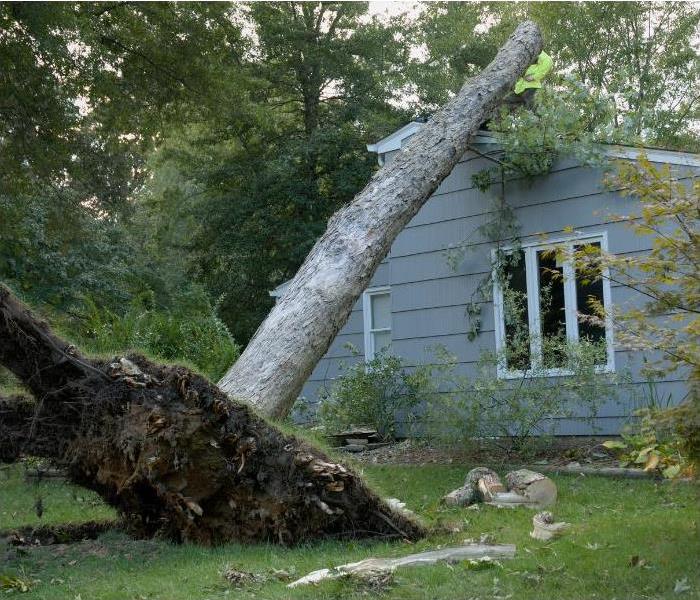 SERVPRO® of Moore is close by and ready to respond to storm and disaster events.
SERVPRO® of Moore is close by and ready to respond to storm and disaster events.
With tornado season upon us again, it’s high time to review some helpful SERVPRO of Moore tips on home storm preparation. Your house is probably your biggest investment; ensuring you have preventative measures in place as we enter the storm season can go a long way to protecting your home from the damage brought about by natural disasters. Without further ado, here are SERVPRO’s eight practical and affordable ways to prepare your home for the storm season:
Clean Your Gutters And Drains
The first places you may want to look at during your storm preparation process are your gutters, downspouts and drains. They play a crucial role in directing rainwater from your roof and away from your house, so it’s essential to ensure they’re free from leaves, debris, and other obstructions. A visual inspection of these roofing components before a storm can help put your mind at ease, knowing that you’ve done your due diligence in fending off roof leaks and basement flooding.
Conduct the Necessary Roof Repairs
It’s best to enlist roof repairs and maintenance regularly to ensure your roof remains stable and in good condition. Getting the cracked or missing shingles on your roof repaired before upcoming storms can help you prevent wind and water from getting through the structure and wreaking havoc inside your home.
Create Your Emergency Supply Kit
A major storm can easily cut off the power and water supply in your area. On top of that, roads can also become flooded or blocked. While no one wants to think these situations can happen to them, it’s better to be safe than sorry. Stocking up on necessities that can last for at least three days is a smart move and must be at the top of your home storm preparation tips. This will help you be more comfortable with the essentials while the storm rages on outside.
Items to stock up on should include:
- Non-perishable food and bottled water
- First-aid kits, emergency medical supplies, and other necessary medications
- Flashlights with spare batteries
- Blankets
- Clothing and toiletries
- Essentials for your pet
Aside from these essentials, you may also add your personal identification and cash to your emergency kit. Important documents such as birth certificates, marriage licenses, wills, insurance policies and other files must be stored in secure storage, like a safety deposit box in your home.
Protect Your Windows
Your glass windows are among the most vulnerable parts of your home, especially in extreme natural disasters like tornadoes. High winds and flying heavy debris can not only send shattered glass flying everywhere but also introduce extensive and expensive damage to your interior.
Nailing pieces of plywood to the outside window frames is an affordable way to protect your windows from flying debris — and yourself from pieces of broken glass. Many property restoration companies can perform this service for you so you don’t have to keep a stock of plywood during storm season.
Cover Your Air Conditioner
During a storm, your outdoor air conditioning unit will be exposed to high winds, heavy rains, and airborne projectiles that can enter it and cause all kinds of damage. An easy and effective solution for this is to invest in a manufacturer-approved protective cover.
Avoiding tarps, garbage bags, and other DIY solutions and getting the proper material may seem pricey at first. However, it’s a worthwhile investment that effectively wards off unwanted debris and moisture that can negatively affect your unit.
Clear Your Yard
Another affordable home storm preparation tip you can follow right now is to clear your yard of anything that can be blown around during the storm. Patio furniture, grills, potted plants, bikes, and other items must be moved indoors. On the other hand, outdoor sculptures like garden gnomes can be secured using burlap or ropes.
While you’re at it, having nearby trees and shrubs evaluated and trimmed is also a good idea. Strong winds can dislodge branches, uproot healthy trees, and cause larger accidents, so securing the surrounding greenery increases the chances of your home — and your trees — surviving the storm.
Listen to the Authorities
The authorities and weather institutions are there to ensure your health and safety, so it’s always best to listen to and take their suggestions seriously, especially when they’re telling you to evacuate. Trying to protect your property by staying home is not worth risking your life.
If you need to evacuate, unplug all appliances, turn off your utilities, and grab only what you need.
If you’ve not been asked to evacuate, listen to updates about the hurricane or storm on the radio, TV, or internet. It’s also recommended to stay inside and away from windows to avoid injuries from broken glass or flying debris. Ultimately, have your emergency supply kit easily accessible so you can leave anytime, especially if you have been ordered to evacuate.
Getting Back to Normal
It’s never easy to prepare for (let alone imagine) overwhelming property damage after a catastrophic storm. However, anticipating the worst-case scenario will help you and your family pave the way to getting back to normal, no matter what happens after the disaster.
Once you have checked off all the home storm preparation tasks listed above, it’s time to plan ahead by identifying the professionals you might need to contact once the storm has passed. For example, knowing a reputable storm recovery team in your area can give you peace of mind knowing you have someone who can help you get things back to normal.
Facing a major storm can leave you feeling worried about your property and your loved ones’ safety. And while these natural disasters can’t be prevented, following the storm preparation tips above can significantly minimize the blows your home will receive. But more importantly, knowing who to turn to after a disaster grants you the assurance that no matter what tomorrow brings, you can get the help you need to restore your property.
If you’re looking for 24/7 flood damage cleanup and storm recovery for your home or business, don’t hesitate to call SERVPRO of Moore now. Our experts are here to make this disaster feel like it never even happened.
SERVPRO Storm Disaster Process
1/26/2023 (Permalink)
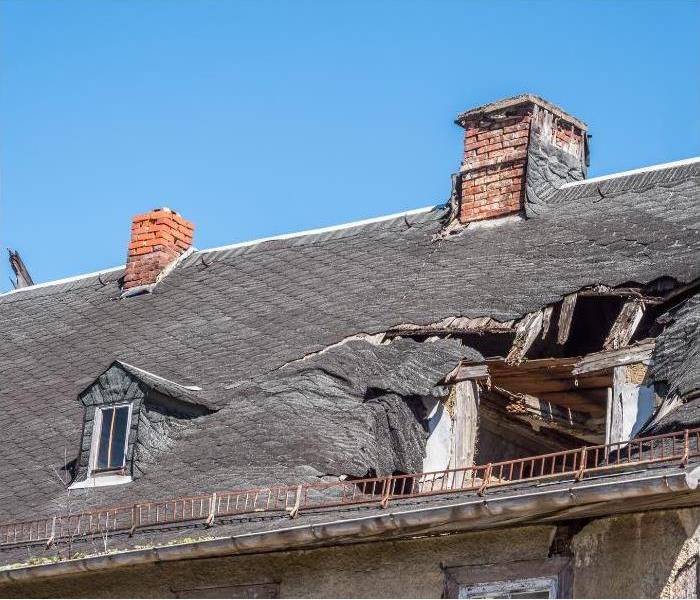 A residential property damaged by heavy storms
A residential property damaged by heavy storms
The first 24 hours following a water loss are the most important in preventing secondary or permanent damage. Within four hours of loss notification, SERVPRO of Moore will have a Professional on-site to help ensure the water damage is handled by completing the following steps.
We will inspect affected areas to determine the extent of water damage and will review the inspection with you to answer any questions before beginning any work.
Then we will take steps to help protect your home or business, as well as personal belongings and other contents, from further damage by extracting the excess water and preparing the area for drying. They will explain the needed emergency services to you step-by-step
To help ensure your home or business
and belongings are dried to appropriate
industry standards, we will monitor the drying process. The updates will be
consistently communicated to you.
Lastly we will repair structural materials, reinstall carpets, and clean affected areas of your property and belongings. A final walk-through of the job-site will be conducted
with you to help ensure the property was returned to pre loss condition.
Tornadoes and Hailstorms - Damages, Seasons,and Details.
1/24/2023 (Permalink)
 someone watching the storm forming
someone watching the storm forming
SERVPRO of Moore and many of us are all too familiar with tornadoes and their associated thunderstorms, hail storms, and the property damage these cause. In fact, it’s common to learn at an early age how best to prepare for these frequent natural disasters; general tips include going into your basement (if you have one) or navigating to a room without windows, staying low, and covering your head. While these basic facts are certainly helpful to remember, there are many additional facts and helpful tips you may not be aware of when it comes to these potentially violent weather events and their subsequent damage.
On a basic level, a tornado is a forcefully rotating column of air, descending from the clouds of a thunderstorm. This column of air is commonly referred to as a funnel cloud. The Enhanced Fujita scale measures the strength of a tornado’s wind, from EF-0 to EF-5, with EF-5 being the strongest.
Tornadoes are often accompanied or precipitated by severe thunderstorms, including hail. Hail is considered a form of precipitation, as it’s solid ice that forms during thunderstorm updrafts. When raindrops are carried upward and freeze, they collide with liquid water droplets; this process compounds and increases the inches in diameter of the hail size before its weight can no longer be supported by the wind, so it falls to the ground.
Avoiding Water Damage During Major Storms
1/19/2023 (Permalink)
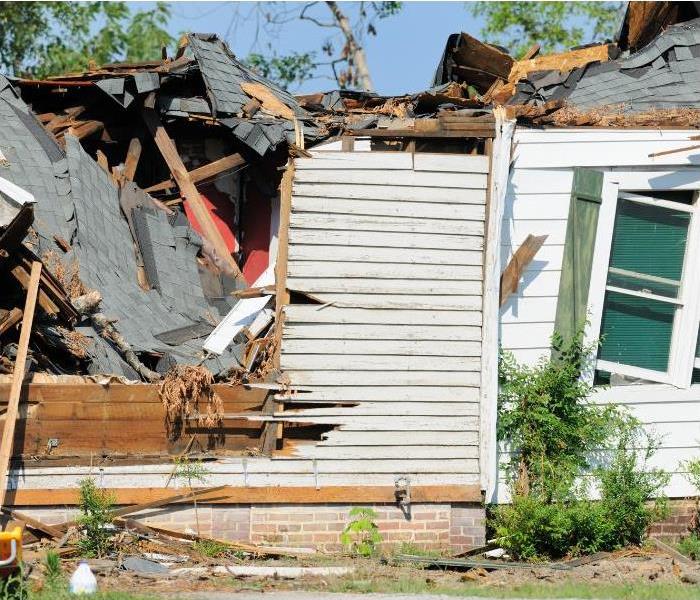 home damage by high winds and heave rainfall
home damage by high winds and heave rainfall
Major storms are one of the main ways that water damage occurs in homes. Our water damage restoration technicians at SERVPRO of Moore commonly deal with the aftermath of storms as they go out to remove water and repair damage in our clients’ homes. As a result, they know several of the most important ways to prevent water damage during a storm. Here are five of these specific ways to keep your home safe during a storm.
Caulk Around Your Doors And Windows
The high winds from a storm can push water against your home with a surprising amount of force. As a result, the water will quickly find its way through any small cracks or holes around the doors or windows. Fortunately, you can easily prevent this problem by applying a fresh layer of caulk around all these points of entry to your home.
Repair Any Cracks Or Holes In The Foundation
Water is crafty and will find its way through any small cracks or holes in your home’s foundation. To make matters worse, this water will gradually cause water damage as it builds up inside your home. Moreover, these cracks and holes often lead to easily-forgotten areas of a home, like basements and crawlspaces so the damage can easily go undetected for a long period of time. Make sure that you have your foundation inspected regularly for any cracks or holes and have it repaired immediately if any are detected.
Move Vulnerable Items Above The Flood Level
While the preferred option is obviously to keep water out of your home completely during a storm. In cases of extremely severe storms, however, some degree of damage may not be preventable. When this is the case, you should move all vulnerable items in your home to higher ground to keep them safe from any floodwater. These items should, at a minimum, include electronics and important documents like passports and birth certificates.
Secure Patio Furniture
Your patio furniture is a great addition to your yard, but they can become deadly projectiles in a storm. This happens when the high winds from the storm picks them up and throws them toward your home. Thus, if you know a storm is imminent, you should place all the patio furniture and other loose items in a safe place where they won’t be able to cause damage during a storm.
Keep Your Rain Gutters Clear
Finally, keeping your gutters clear is a must for protecting your home from water damage during a storm. If you fail to do so, the rain from a storm will run over the top of your gutters, and the pool around your home significantly increases the likelihood that your home sustains water damage.
HOW TO RESTORE YOUR HOME AFTER A NATURAL DISASTER
1/4/2023 (Permalink)
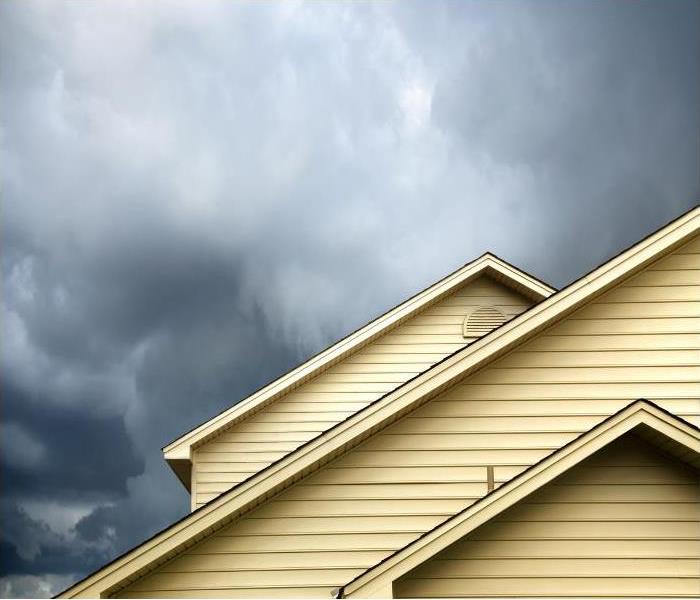 SERVPRO here to help
SERVPRO here to help
It’s been a tough year for everyone, and natural disasters have taken a toll on many homes. If your home has been affected by a hurricane, tornado, or another disaster, you may be wondering how to restore it to its former glory. Luckily, there are some steps you can take to get your home back in shape. In this blog post, we’ll share some tips on how to restore your home after a natural disaster. Whether you’re dealing with water damage, wind damage, or something else, these tips will help you get your home back to normal. So if you’re ready to start the restoration process, read on!
The first step is to assess the damage. Take a look around your home and make a list of all the damaged items. Once you have a list, you can start to prioritize which repairs need to be made first. If there is structural damage, this should be your first priority. Structural damage is any damage that affects the load-bearing components of a home, such as the foundation, walls, ceilings, and/or roof. This type of damage can make a home unsafe to live in and can be very costly to repair.
In addition, if there is water damage, you will need to dry out your home and remove any mold or mildew that has formed. Water can enter your home through holes or cracks in the foundation, windows, or doors; through the roof; or from rising floodwaters. Once inside, water can damage floors, walls, furniture, and personal belongings. It can also lead to mold growth, which can pose serious health risks.
Once you have assessed the damage, it’s time to start cleaning up. First, make a plan of action. Write down what needs to be done and in what order. This will help you stay organized and avoid overlooking any important tasks. Then start with the basics. Begin by cleaning up any debris that may be inside or outside your home. This includes broken glass, downed tree limbs, etc. Finally, move on to bigger tasks next. If there is water damage, start by drying out the affected areas. Then, you can begin to repair any damage that has been done.
After you have cleaned up the debris and repaired any damage, it’s time to start thinking about prevention. Take a look at your home and identify any areas that are vulnerable to future disasters. Make sure you have strong doors and windows and consider installing storm shutters or hurricane straps. For example, storm shutters are one of the most important things you can do to protect your home from damage during a severe storm. They can be made from a variety of materials, but the most common type is metal. Taking these precautions will help you avoid future damage and make your home safer in the event of another disaster.
Restoring your home after a natural disaster can be daunting, but it is possible with the help of a professional restoration company. SERVPRO of Moore has years of experience helping homeowners recover from storms, floods, and fires. Contact us today, and we will get started on restoring your home to its original condition.
Lightning Facts for Moore Residents
12/20/2021 (Permalink)
As one of the leading weather-related causes of death or injury in the nation, lighting deserves to be understood better so we can be both awed and avoidant of it.
At SERVPRO® of Moore, we strive to be knowledgeable, proactive and preventative in approaching the stormy seasons of Oklahoma.
Here are some flash facts about lightning:
- While the speed of light (when we see the bolt) is 670,000,000 mph, the actual speed of a strike is only 27,000 mph. Need help visualizing this? Imagine traveling to the moon in only 55 minutes.
- Everyday, there are over 3 million flashes of lightning (about 44 strikes each second). The earth is struck by lightning more than 100 bolts each second.
- Lightning can help plants grow through creating nitrogen oxides by its heat and combining with moisture to provide nitrate-rich water for plants.
- The width of a bolt is only about 2 to 3 centimeters (about the size of a thumb) but it spans a length of about 2 to 3 miles.
- Lightning can reach up to 50,000°F, which is about 5x hotter than the sun’s surface.
- Thunderstorms aren’t the only source of lightning; it can be found in volcanic eruptions, forest fires, nuclear detonations, snowstorms and hurricanes.
- Using surge protectors won’t actually protect your appliances against direct strikes, so make sure to unplug all of your equipment.
- Using the phone while indoors is actually the leading cause of injuries by lightning within a household.
- You can easily be struck by lightning even if the eye of the storm is 10 miles away.
Lightning isn’t something to mess with or worth taking any chances at the risk of death or injury. It must be taken seriously, but we can admire the beauty and nature of lightning without compromising our safety.
And should your home or commercial property incur any damage from a lightning strike or other severe weather event, we're on call 24/7 and faster to any disaster. Just give us a call at (405) 289-9401 and we'll be on our way.
What the Hurricane Categories Actually Mean
12/20/2021 (Permalink)
While we don't get hurricanes, we can still be affected by their weather patterns, and we often have friends and family who live where hurricanes occur. So what do the hurricane categories actually mean anyways?
Hurricanes are categorized by the Saffir-Simpson Hurricane Wind Scale, which is rated 1 to 5 based on maximum ongoing wind speed. The scale was developed in the 70s by Herbert Saffir, an engineer in Miami, and Robert Simpson, a meteorologist and former director of the National Hurricane Center.
The scale doesn’t factor other hazards that result from hurricanes such as storm surges, flooding and tornadoes, but it does estimate the probable damage of property. Although category 3 or higher are known as major hurricanes, all categories have the ability to result in major damage.
At SERVPRO of Moore, we’re committed to understanding the storms our communities are enduring and finding practical solutions and preventative measures for each scenario. Here’s a rundown of the different categories of hurricanes to watch out for:
CATEGORY 1 — Winds are 74 to 95 mph
Winds are considered very dangerous and expected to produce some damage. Homes with well-structured frames might suffer roof damage, large tree branches could snap or trees with shallow roots may fall over. If power lines or poles are damaged, it could result in power outages lasting up to several days.
CATEGORY 2 — Winds are 96 to 110 mph
Winds are considered extremely dangerous and expected to cause extensive damage. Houses may endure major roof damage and trees could easily snap or be uprooted, blocking roads. It is expected for an almost total power outage to occur and last up to a few weeks.
CATEGORY 3 — Winds are 111 to 129 mph
Winds are expected to cause devastating damage. Framed homes will suffer major roof damage including removal of parts of the roof. Trees are easily snapped and uprooted, blocking major roads. Electricity and water expected to be unavailable up to several weeks post-storm.
CATEGORY 4 — Winds are 130 to 156 mph
Winds are expected to cause catastrophic damage. Houses will experience severe damage including a loss of the majority of the roof structure as well as exterior walls. Trees will be snapped and uprooted along with power poles, isolating areas in the community. Power outages can last up to months and the area will remain uninhabitable for weeks to months.
CATEGORY 5 — Winds are 157 mph or more
Severe winds are expected to cause catastrophic damage as well. Houses will be destroyed, including total roof failure and collapse of walls or structure. Trees and power poles that have fallen will isolate communities. Outages are expected to last for weeks or months as well as the area being uninhabitable for quite some time.
SERVPRO of Moore hopes to serve the community by providing this knowledge for people to understand and always be weather prepared.
Protect Your Roof From Wind Damage
12/20/2021 (Permalink)
A roof is a vital protective feature of your home, but you lose that protection when strong winds cause roof damage. These are some features of a roof that can determine wind damage and tips for preventing it.
Factors Contributing To Damage
Protecting your home's roof means understanding its vulnerabilities, which may include:
- Construction materials
- Construction quality
- Age
- Shape
- Slope
Some materials are better suited to withstand the elements than others. For example, slate roofs are significantly more durable than asphalt roofs, though roofs over twenty years old should have routine inspections for hidden damage that could worsen after a storm.
When wind hits your home's sides, it starts to move upward, creating pressure as it goes, until it reaches the edges of your roof, where it exerts a maximum force. It then travels along your roof's surface, where it creates a suction-like pull against roof materials that can be strong enough to loosen or dislodge shingles. Sound construction can help a roof withstand these forces. Roof damage is also avoidable when roofs consist of multiple panels having 30-degree slopes.
How To Prevent and Reduce Damage
Routine roof inspections are critical for protecting your roof from wind damage. Scheduling inspections during mild seasons can ensure that you have plenty of time to perform repairs before severe weather hits.
Wind can also indirectly damage your home if it carries debris that it deposits on your roof. The weight of tree limbs and other objects, including laws furniture that strong winds are capable of lifting to your rooftop, can puncture, crack and loosen shingles. Clearing objects and debris from the ground surrounding your home can help prevent them from landing on your roof during a storm.
Storm Recovery
When roof damage happens, it is crucial to protect your home with tarping and begin repairs as soon as possible. If a storm results in damage to your home's interior, you can count on a storm restoration service like SERVPRO of Moore to handle the clean-up.
Protecting Your Home During Storm Season
10/5/2021 (Permalink)
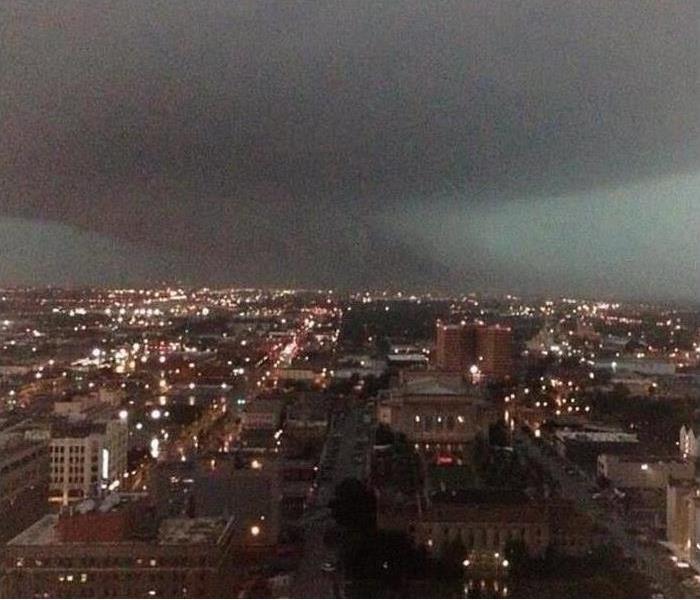 Storm skies and a tornado over downtown Oklahoma City.
Storm skies and a tornado over downtown Oklahoma City.
Protecting Your Home During Storm Season
Residents of Oklahoma City are no stranger to thunderstorms, hail, tornadoes, and strong winds. Tornado season is really all year in Oklahoma, but a peak does occur late March through August. This is when the prime conditions for tornadoes are met in Oklahoma. AccuWeather has predicted that there will be a five percent increase in the number of tornadoes that touch down in Oklahoma this, which could mean anywhere from 1,350 to 1,450 tornadoes. Tornadoes and the other acclimate weather associated with them mean that areas all over Oklahoma are at an increased risk of facing severe weather events during this period of time. Here is a list of preventive measures Oklahoman home and business owners can take to protect themselves and their properties against the challenging weather ahead:
-Keep the trees and branches near your home trimmed. This will make them more resistant to wind. Excess water can weigh down smaller and/or weaker branches, causing them to break off at a higher rate than larger branches. Take this into account when maintain your foliage.
-Secure fences and outdoor furniture. Heavy winds often accompany storm season. Protect the exterior of your home by ensuring that anything that could potentially turn into flying debris during acclimate weather is properly secured or stored.
-Protect critical areas. Storms and winds are a major threat to doors, roofs, and windows. The installation of temporary protection during a stretch of time where acclimate weather is predicted to occur again and again can prove to be incredibly beneficial to both business and home owners. SERVPRO of Central Oklahoma City is happy to provide board up services to both commercial and residential properties.
-Check your gutters. Be sure to clear your gutters of any debris and to ascertain that your downspouts are draining away from your home. Buildup in your gutters can cause storm water to overflow which cause both internal and external damage to your property.
It is our sincere hope that these tips will help to protect your home or business during storm season. In the event that your home is affected by storms, fires, leaks, flooding, mold, or any other sort of undesirable incident SERVPRO of Central Oklahoma City offers reconstruction and restoration services to help you manage the damage and make it "Like it never even happened."
 SERVPRO® of Moore is Here to Help, even on weekends. Our team of experts is on call 24/7 to respond to any emergency, no matter the size.
SERVPRO® of Moore is Here to Help, even on weekends. Our team of experts is on call 24/7 to respond to any emergency, no matter the size.



 24/7 Emergency Service
24/7 Emergency Service





